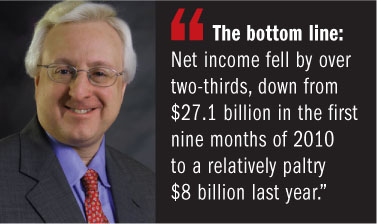Read ’em and weep, folks! I couldn’t help but cringe a bit as Ireviewed the P&C industry’s consolidated results for the firstthree quarters of 2011. It was bad news galore. Even the few bitsof “good” news had a negative tinge.
| Let’s start with the bottom line:Net income fell by over two-thirds, down from $27.1 billion in thefirst nine months of 2010 to a relatively paltry $8 billion lastyear. That sent the industry’s rate of return plummeting to ameasly 1.9 percent, compared with a below-average butstill-respectable 6.8 percent in 2010.
Let’s start with the bottom line:Net income fell by over two-thirds, down from $27.1 billion in thefirst nine months of 2010 to a relatively paltry $8 billion lastyear. That sent the industry’s rate of return plummeting to ameasly 1.9 percent, compared with a below-average butstill-respectable 6.8 percent in 2010.
I admit there were mitigating circumstances to consider.Unusually high catastrophe losses were clearly a prime factor inthe industry’s poor showing thus far for 2011, tripling from $10.8billion through the first nine months of 2010 to a staggering $33.2billion last year.
|However, ISO noted that even if cat losses last year had beenthe same as they were in 2010, the combined ratio would still haverisen 1.7 points through nine months to 102.9, which is nothing towrite home about.
|The industry may also take some comfort from the fact that therate of return was impacted by severely negative numbers posted bymortgage and financial-guaranty carriers. Excluding those insurers,the rate of return was actually 3 percent. But that was still downconsiderably from the 7.8 percent posted in 2010—again, no causefor bragging.
|Under these conditions, it’s no wonder policyholder surplus wasdrained a bit, falling $20.6 billion (3.7 percent) from year-end2010 to a still hefty $538.6 billion after nine months last year.The industry likely remains overcapitalized given the slow growthin insurable exposures, but the big question is what insurers willdo with that excess capacity.
|The good news (at least for sellers, but not buyers ofinsurance) is that higher prices in both commercial and personallines for many accounts boosted net-written premiums by 3.1 percentover the first nine months of 2011—the highest growth rate postedsince 2006. It certainly beat 2010’s 1.2 percent gain and 2009’s4.6 percent decline.
|In addition, after excluding those nasty mortgage andfinancial-guaranty results once again, those writing primarilycommercial lines saw premium volume rise by 3.9 percent, comparedto a decline of 1.9 percent the previous year.
|However, temper that with the news that those primarily writingpersonal lines saw growth slow a bit to 3.1 percent, down from 3.6percent in 2010. And keep in mind that even without the effects ofcatastrophes, insured losses and loss-adjustment expenses were up5.1 percent—which means the industry overall is still losingground.
|So where does that leave the P&C industrygoing into 2012? That depends on a number of factors:
- Is the nine-month surplus decline indicative of the P&Cindustry consciously burning through excess capital, or is it justthe result of a bad year of cat losses?
- Will insurers have the underwriting discipline to walk awayfrom underpriced risks, or will they seek greater market share bycompeting more aggressively on price, undermining the staying powerof what has been a firming commercial and personal-linesmarket?
- Will insurers raise prices high enough to make up for risinglosses and weaker bond yields, so they can produce a decent rate ofreturn for a change?
Of course, all bets are off if the fragile U.S. economicrecovery stalls thanks to the crises in the Eurozone, apetering-out of federal stimulus funds, cuts in state-governmentspending, a lingering housing-market slump, federal-governmentparalysis in this election year, or any combination of these andother factors yet to emerge.
|The other major question will be what happens with cat losses in2012. Last year may have been unusual in terms of disaster losses,but then again, given the speculation about climate change, mightthis be the “new normal” for insurers?
|And even though disaster claims soared last year, outside ofHurricane Irene, we didn’t have a monster storm slam into the U.S.mainland. If one should hit Florida or the Gulf Coast (or even NewYork—Irene was way too close a call for someone like me, livingnear Brooklyn’s beaches), industry surplus could be drained in ahurry.
|The top insurance company CEOs and heads of the majorassociations recently came together for their annual familyreunion—better known as the P&C Joint Industry Forum—and itwill be interesting to hear what was on their minds when reportsfrom what was discussed at the event start to appear.
|Most likely, it will be anything but business as usual forinsurers in 2012: They’ll have to cope with the threat of mountingcat exposures, declining bond-investment returns and an uncertaineconomic recovery.
|And a Happy New Year to you, too!
Want to continue reading?
Become a Free PropertyCasualty360 Digital Reader
Your access to unlimited PropertyCasualty360 content isn’t changing.
Once you are an ALM digital member, you’ll receive:
- All PropertyCasualty360.com news coverage, best practices, and in-depth analysis.
- Educational webcasts, resources from industry leaders, and informative newsletters.
- Other award-winning websites including BenefitsPRO.com and ThinkAdvisor.com.
Already have an account? Sign In
© 2024 ALM Global, LLC, All Rights Reserved. Request academic re-use from www.copyright.com. All other uses, submit a request to [email protected]. For more information visit Asset & Logo Licensing.








